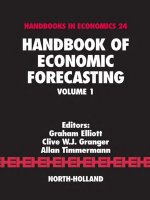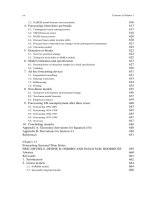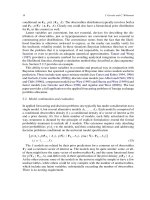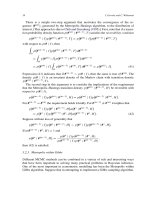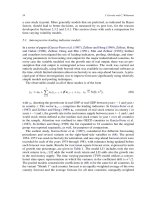Handbook of Economic Forecasting part 21 pps
Bạn đang xem bản rút gọn của tài liệu. Xem và tải ngay bản đầy đủ của tài liệu tại đây (119.52 KB, 10 trang )
174 A. Timmermann
where e is an N ×T matrix of forecast errors. Letting
ˆ
f
ij
be the (i, j) entry of
ˆ
ef
, ˆσ
ij
the (i, j) element of
ˆ
e
and φ
ij
the (i, j) element of the single factor covariance matrix,
ef
, while σ
ij
is the (i, j) element of
e
, they demonstrate that the optimal shrinkage
takes the form
α
∗
=
1
T
π − ρ
γ
+ O
1
T
2
,
where
π =
N
i=1
N
j=1
AsyVar
√
T ˆσ
ij
,
ρ =
N
i=1
N
j=1
AsyCov
√
T
ˆ
f
ij
,
√
T ˆσ
ij
,
γ =
N
i=1
N
j=1
(φ
ij
− σ
ij
)
2
.
Hence, π measures the (scaled) sum of asymptotic variances of the sample covariance
matrix (
ˆ
e
), ρ measures the (scaled) sum of asymptotic covariances of the sample co-
variance matrix (
ˆ
e
) and the single-factor covariance matrix (
ˆ
ef
), while γ measures
the degree of misspecification (bias) in the single factor model. Ledoit and Wolf propose
consistent estimators ˆπ, ˆρ and ˆγ under the assumption of IID forecast errors.
13
5.2. Constraints on combination weights
Shrinkage bears an interesting relationship to portfolio weight constraints in finance.
It is commonplace to consider minimization of portfolio variance subject to a set of
equality and inequality constraints on the portfolio weights. Portfolio weights are often
constrained to be non-negative (due to no short selling) and not to exceed certain upper
bounds (due to limits on ownership in individual stocks). Reflecting this, let
ˆ
be an
estimate of the covariance matrix for some cross-section of asset returns with row i,
column j element
ˆ
[i, j ] and consider the optimization program
ω
∗
= argmin
ω
1
2
ω
ˆ
ω
(71)
s.t. ω
ι = 1,
ω
i
0,i= 1, ,N,
ω
i
¯ω, i = 1, ,N.
13
It is worth pointing out that the assumption that e is IID is unlikely to hold for forecast errors which could
share common dynamics in first, second or higher order moments or even be serially correlated, cf. Diebold
(1988).
Ch. 4: Forecast Combinations 175
This gives a set of Kuhn–Tucker conditions:
j
ˆ
[i, j ]ω
j
− λ
i
+ δ
i
= λ
0
0,i= 1, ,N,
λ
i
0 and λ
i
= 0ifω
i
> 0,
δ
i
0 and δ
i
= 0ifω
i
< ¯ω.
Lagrange multipliers for the lower and upper bounds are collected in the vectors λ =
(λ
1
, ,λ
N
)
and δ = (δ
1
, ,δ
N
)
; λ
0
is the Lagrange multiplier for the constraint
that the weights sum to one.
Constraints on combination weights effectively have two effects. First, they shrink
the largest elements of the covariance matrix towards zero. This reduces the effects of
estimation error that can be expected to be strongest for assets with extreme weights.
The second effect is that it may introduce specification errors to the extent that the true
population values of the optimal weights actually lie outside the assumed interval.
Jaganathan and Ma (2003) show the following result. Let
(72)
˜
=
ˆ
+
δι
+ ιδ
−
λι
+ ιλ
.
Then
˜
is symmetric and positive semi-definite. Constructing a solution to the inequal-
ity constrained problem (71) is shown to be equivalent to finding the optimal weights
for the unconstrained quadratic form based on the modified covariance matrix in (72)
˜
=
ˆ
+ (δι
+ ιδ
) − (λι
+ ιλ
).
Furthermore, it turns out that
˜
can be interpreted as a shrinkage version of
ˆ
.Tosee
this, consider the weights that are affected by the lower bound so
˜
=
ˆ
−(λι
+ ιλ
).
When the constraint for the lower bound is binding (so a combination weight would
have been negative), the covariances of a particular forecast error with all other errors
are reduced by the strictly positive Lagrange multipliers and its variance is shrunk.
Imposing the non-negativity constraints shrinks the largest covariance estimates that
would have resulted in negative weights. Since the largest estimates of the covariance
are more likely to be the result of estimation error, such shrinkage can have the effect of
reducing estimation error and have the potential to improve out-of-sample performance
of the combination.
In the case of the upper bounds, those forecasts whose unconstrained weights would
have exceeded ¯ω are also the ones for which the variance and covariance estimates tend
to be smallest. These forecasts have strictly positive Lagrange multipliers on the upper
bound constraint, meaning that their forecast error variance will be increased by 2δ
i
while the covariances in the modified covariance matrix
˜
will be increased by δ
i
+δ
j
.
Again this corresponds to shrinkage towards the cross-sectional average of the variances
and covariances.
176 A. Timmermann
6. Combination of interval and probability distribution forecasts
So far we have focused on combining point forecasts. This, of course, reflects the fact
that the vast majority of academic studies on forecasting only report point forecasts.
However, there has been a growing interest in studying interval and probability distri-
bution forecasts and an emerging literature in economics is considering the scope for
using combination methods for such forecasts. This is preceded by the use of combined
probability forecasting in areas such as meteorology, cf. Sanders (1963). Genest and
Zidek (1986) present a broad survey of various techniques in this area.
6.1. The combination decision
As in the case of combinations of point forecasts it is natural to ask whether the best
strategy is to use only a single probability forecast or a combination of these. This is
related to the concept of forecast encompassing which generalizes from point to density
forecasts as follows. Suppose we are considering combining N distribution forecasts
f
1
, ,f
N
whose joint distribution with y is P(y,f
1
,f
2
, ,f
N
). Factoring this into
the product of the conditional distribution of y given f
1
, ,f
N
, P(y|f
1
, ,f
N
), and
the marginal distribution of the forecasts, P(f
1
, ,f
N
),wehave
(73)P(y,f
1
,f
2
, ,f
N
) = P(y|f
1
, ,f
N
)P (f
1
, ,f
N
).
A probability forecast that does not provide information about y given all the other prob-
ability density forecasts is referred to as extraneous by Clemen, Murphy and Winkler
(1995).Iftheith forecast is extraneous we must have
(74)P(y|f
1
,f
2
, ,f
N
) = P(y|f
1
,f
2
, ,f
i−1
,f
i+1
, ,f
N
).
If (74) holds, probability forecast f
i
does not contain any information that is useful for
forecasting y given the other N − 1 probability forecasts. Only if forecast i does not
satisfy (74) does it follow that this model is not encompassed by the other models. In-
terestingly, adding more forecasting models (i.e. increasing N ) can lead a previously
extraneous model to become non-extraneous if it contains information about the rela-
tionship between the existing N − 1 methods and the new forecasts.
For pairwise comparison of probability forecasts, Clemen, Murphy and Winkler
(1995) define the concept of sufficiency. This concept is important because if forecast 1
is sufficient for forecast 2, then 1’s forecasts will be of greater value to all users than
forecast 2. Conversely, if neither model is sufficient for the other we would expect some
forecast users to prefer model 1 while others prefer model 2. To illustrate this con-
cept, consider two probability forecasts, f
1
= P
1
(x = 1) and f
2
= P
2
(x = 1) of
some event, X, where x = 1 if the event occurs while it is zero otherwise. Also let
v
1
(f ) = P(f
1
= f) and v
2
(g) = P(f
2
= g), where f, g ∈ G, and G is the set of
permissible probabilities. Forecast 1 is then said to be sufficient for forecast 2 if there
Ch. 4: Forecast Combinations 177
exists a stochastic transformation ζ(g|f)such that for all g ∈ G,
f
ζ(g|f)v
1
(f ) = v
2
(g),
f
ζ(g|f)fv
1
(f ) = gv
2
(g).
The function ζ(g|f) is said to be a stochastic transformation provided that it lies be-
tween zero and one and integrates to unity. It represents an additional randomization
that has the effect of introducing noise into the first forecast.
6.2. Combinations of probability density forecasts
Combinations of probability density or distribution forecasts impose new requirements
beyond those we saw for combinations of point forecasts, namely that the combination
must be convex with weights confined to the zero-one interval so that the probability
forecast never becomes negative and always sums to one.
This still leaves open a wide set of possible combination schemes. An obvious way
to combine a collection of probability forecasts {F
t+h,t,1
, ,F
t+h,t,N
} is through the
convex combination (“linear opinion pool”):
(75)
¯
F
c
=
N
i=1
ω
t+h,t,i
F
t+h,t,i
,
with 0 ω
t+h,t,i
1(i = 1, ,N) and
N
i=1
ω
t+h,t,i
= 1 to ensure that the
combined probability forecast is everywhere non-negative and integrates to one. The
generalized linear opinion pool adds an extra probability forecast, F
t+h,t,0
, and takes
the form
(76)
¯
F
c
=
N
i=0
ω
t+h,t,i
F
t+h,t,i
.
Under this scheme the weights are allowed to be negative ω
0
,ω
1
, ,ω
n
∈[−1, 1]
although they still are restricted to sum to unity:
N
i=0
ω
t+h,t,i
= 1.F
t+h,t,0
can be
shown to exist under conditions discussed by Genest and Zidek (1986).
Alternatively, one can adopt a logarithmic combination of densities
(77)
¯
f
l
=
N
i=1
f
ω
t+h,t,i
t+h,t,i
N
i=1
f
ω
t+h,t,i
t+h,t,i
dμ,
where {ω
t+h,t,1
, ,ω
t+h,t,N
} are weights chosen such that the integral in the denom-
inator is finite and μ is the underlying probability measure. This combination is less
dispersed than the linear combination and is also unimodal, cf. Genest and Zidek (1986).
178 A. Timmermann
6.3. Bayesian methods
Bayesian approaches have been widely used to construct combinations of probability
forecasts. For example, Min and Zellner (1993) propose combinations based on pos-
terior odds ratios. Let p
1
and p
2
be the posterior probabilities of two models (a fixed
parameter and a time-varying parameter model in their application) while k = p
1
/p
2
is
the posterior odds ratio of the two models. Assuming that the two models, M
1
and M
2
,
are exhaustive the proposed combination scheme has a conditional mean of
E[y]=p
1
E[y|M
1
]+(1 − p
1
)E[y|M
2
]
(78)=
k
1 + k
E[y|M
1
]+
1
1 + k
E[y|M
2
].
Palm and Zellner (1992) propose a combination method that accounts for the full cor-
relation structure between the forecast errors. They model the one-step forecast errors
from the individual models as follows:
(79)y
t+1
−ˆy
it+1,t
= θ
i
+ ε
it+1
+ η
t+1
,
where θ
i
is the bias in the ith model’s forecast – reflecting perhaps the forecaster’s
asymmetric loss, cf. Zellner (1986) – ε
it+1
is an idiosyncratic forecast error and η
t+1
is
a common component in the forecast errors reflecting an unpredictable component of
the outcome variable. It is assumed that both ε
it+1
∼ N(0,σ
2
i
) and η
t+1
∼ N(0,σ
2
η
)
are serially uncorrelated (as well as mutually uncorrelated) Gaussian variables with zero
mean.
For the case with zero bias (θ
i
= 0), Winkler (1981) shows that when ε
it+1
+ η
t+1
(i = 1, ,N) has known covariance matrix,
0
, the predictive density function of
y
t+1
given an N-vector of forecasts
ˆ
y
t+1,t
= ( ˆy
t+1,t,1
, , ˆy
t+1,t,N
)
is Gaussian with
mean ι
−1
0
ˆ
y
t+1,t
/ι
0
ι and variance ι
−1
0
ι. When the covariance matrix of the N
time-varying parts of the forecast errors ε
it+1
+η
t+1
, , is unknown but has an inverted
Wishart prior IW(|
0
,δ
0
,N)with δ
0
N, the predictive distribution of y
T +1
given
F
T
={y
1
, ,y
T
,
ˆ
y
2,1
, ,
ˆ
y
T,T−1
,
ˆ
y
T +1,T
) is a univariate student-t with degrees of
freedom parameter δ
0
+ N − 1, mean m
∗
= ι
−1
0
ˆ
y
T +1,T
/ι
−1
0
ι and variance
(δ
0
+N −1)s
∗2
/(δ
0
+N −3), where s
∗2
= (δ
0
+(m
∗
ι−
ˆ
y
T +1,T
)
−1
0
(m
∗
ι−
ˆ
y
T +1,T
))/
(δ
0
+ N − 1)ι
−1
0
ι.
Palm and Zellner (1992) extend these results to allow for a non-zero bias. Given a
set of N forecasts
ˆ
y
t+1,t
over T periods they express the forecast errors y
t
−ˆy
t,t−1,i
=
θ
i
+ ε
it
+ η
t
as a T × N multivariate regression model:
Y = ιθ + U.
Suppose that the structure of the forecast errors (79) is reflected in a Wishart prior for
−1
with v degrees of freedom and covariance matrix
0
=
ε0
+σ
2
η0
ιι
(with known
Ch. 4: Forecast Combinations 179
parameters v,
ε0
,σ
2
η0
):
P
−1
∝
−1
(v−N−1)/2
−1
0
−v/2
exp
−
1
2
tr
0
−1
.
Assuming a sample of T observations and a likelihood function
L
θ,
−1
|F
T
∝
−1
−T/2
exp
−
1
2
tr
S
−1
−
1
2
tr
θ −
ˆ
θ
ι
ι
θ −
ˆ
θ
−1
,
where
ˆ
θ = (ι
ι)
−1
ι
Y and S = (Y−ι
ˆ
θ
)
(Y−ι
ˆ
θ
), Palm and Zellner derive the predictive
distribution function of y
T +1
given F
T
:
P(y
T +1
|F
T
) ∝
1 + (y
T +1
−¯μ)
2
(T − 1)s
∗∗2
−(T +v)/2
,
where ¯μ = ι
¯
S
−1
ˆ
μ/ι
¯
S
−1
ι, s
∗∗2
=[T +1+T(¯μι−
ˆ
μ)
¯
S
−1
( ¯μι−
ˆ
μ)]/(T (T −1)ι
¯
S
−1
ι),
ˆ
μ =ˆy
T +1
−
ˆ
θ and
¯
S = S +
0
. This approach provides a complete solution to the
forecast combination problem that accounts for the joint distribution of forecast errors
from the individual models.
6.3.1. Bayesian model averaging
Bayesian Model Averaging methods have been proposed by, inter alia, Leamer (1978),
Raftery, Madigan and Hoeting (1997) and Hoeting et al. (1999) and are increasingly
used in empirical studies, see, e.g., Jackson and Karlsson (2004). Under this approach,
the predictive density can be computed by averaging over a set of models, i = 1, ,N,
each characterized by parameters θ
i
:
(80)f(y
t+h
|F
t
) =
N
i=1
Pr(M
i
|F
t
)f
i
(y
t+h
, θ
i
|F
t
),
where Pr(M
i
|F
t
) is the posterior probability of model M
i
obtained from the model
priors Pr(M
i
), the priors for the unknown parameters, Pr(θ
i
|M
i
), and the likelihood
functions of the models under consideration. f
i
(y
t+h
, θ
i
|F
t
) is the density of y
t+h
and
θ
i
under the ith model, given information at time t, F
t
. Note that unlike the combination
weights used for point forecasts such as (12), these weights do not account for correla-
tions between forecasts. However, the approach is quite general and does not require the
use of conjugate families of distributions. More details are provided in the Handbook
Chapter 1 by Geweke and Whitemann (2006).
6.4. Combinations of quantile forecasts
Combinations of quantile forecasts do not pose any new issues except for the fact that
the associated loss function used to combine quantiles is typically no longer continuous
and differentiable. Instead predictions of the αth quantile can be related to the ‘tick’ loss
180 A. Timmermann
function
L
α
(e
t+h,t
) = (α −1
e
t+h,t
<0
)e
t+h,t
,
where 1
e
t+h,t
<0
is an indicator function taking a value of unity if e
t+h,t
< 0, and is
otherwise zero, cf. Giacomini and Komunjer (2005). Given a set of quantile forecasts
q
t+h,t,1
, ,q
t+h,t,N
, quantile forecast combinations can then be based on formulas
such as
q
c
t+h,t
=
N
i=1
ω
i
q
t+h,t,i
,
possibly subject to constraints such as
N
i=1
ω
i
= 1.
More caution should be exercised when forming combinations of interval forecasts.
Suppose that we have N interval forecasts each taking the form of a lower and an upper
limit {l
t+h,t,i
;u
t+h,t,i
}. While weighted averages {
¯
l
c
t+h,t,i
;¯u
c
t+h,t,i
}
(81)
¯
l
c
t+h,t,i
=
N
i=1
ω
l
t+h,t,i
l
t+h,t,i
,
¯u
c
t+h,t,i
=
N
i=1
ω
u
t+h,t,i
u
t+h,t,i
may seem natural, they are not guaranteed to provide correct coverage rates. To see this,
consider the following two 97% confidence intervals for a normal mean:
¯y − 2.58
σ
T
, ¯y + 1.96
σ
T
,
¯y − 1.96
σ
T
, ¯y + 2.58
σ
T
.
The average of these confidence intervals, [¯y − 2.27
σ
T
, ¯y + 2.27
σ
T
] has a coverage of
97.7%. Combining confidence intervals may thus change the coverage rate.
14
The prob-
lem here is that the underlying end-points for the two forecasts (i.e. ¯y − 2.58
σ
T
and
¯y − 1.96
σ
T
) are not estimates of the same quantiles. While it is natural to combine es-
timates of the same α-quantile, it is less obvious that combination of forecast intervals
makes much sense unless one can be assured that the end-points are lined up and are
estimates of the same quantiles.
14
I am grateful to Mark Watson for suggesting this example.
Ch. 4: Forecast Combinations 181
7. Empirical evidence
The empirical literature on forecast combinations is voluminous and includes work in
several areas such as management science, economics, operations research, meteorol-
ogy, psychology and finance. The work in economics dates back to Reid (1968) and
Bates and Granger (1969). Although details and results vary across studies, it is possi-
ble to extract some broad conclusions from much of this work. Such conclusions come
with a stronger than usual caveat emptor since for each point it is possible to construct
counter examples. This is necessarily the case since findings depend on the number of
models, N (as well as their type), the sample size, T , the extent of instability in the un-
derlying data set and the structure of the covariance matrix of the forecast errors (e.g.,
diagonal or with similar correlations).
Nevertheless, empirical findings in the literature on forecast combinations broadly
suggest that (i) simple combination schemes are difficult to beat. This is often explained
by the importance of parameter estimation error in the combination weights. Conse-
quently, methods aimed at reducing such errors (such as shrinkage or combination
methods that ignore correlations between forecasts) tend to perform well; (ii) forecasts
based exclusively on the model with the best in-sample performance often leads to poor
out-of-sample forecasting performance; (iii) trimming of the worst models and clus-
tering of models with similar forecasting performance prior to combination can yield
considerable improvements in forecasting performance, especially in situations involv-
ing large numbers of forecasts; (iv) shrinkage to simple forecast combination weights
often improves performance; and (v) some time-variation or adaptive adjustment in the
combination weights (or perhaps in the underlying models being combined) can often
improve forecasting performance. In the following we discuss each of these points in
more detail. The section finishes with a brief empirical application to a large macroeco-
nomic data set from the G7 economies.
7.1. Simple combination schemes are hard to beat
It has often been found that simple combinations – that is, combinations that do not
require estimating many parameters such as arithmetic averages or weights based on the
inverse mean squared forecast error – do better than more sophisticated rules relying
on estimating optimal weights that depend on the full variance-covariance matrix of
forecast errors, cf. Bunn (1985), Clemen and Winkler (1986), Dunis, Laws and Chauvin
(2001), Figlewski and Urich (1983) and Makridakis and Winkler (1983).
Palm and Zellner (1992, p. 699) concisely summarize the advantages of adopting a
simple average forecast:
“1. Its weights are known and do not have to be estimated, an important advantage
if there is little evidence on the performance of individual forecasts or if the
parameters of the model generating the forecasts are time-varying;
2. In many situations a simple average of forecasts will achieve a substantial reduc-
tion in variance and bias through averaging out individual bias;
182 A. Timmermann
3. It will often dominate, in terms of MSE, forecasts based on optimal weighting if
proper account is taken of the effect of sampling errors and model uncertainty on
the estimates of the weights.”
Despite the impressive empirical track record of equal-weighted forecast combina-
tions we stress that the theoretical justification for this method critically depends on the
ratio of forecast error variances not being too far away from unity. They also depend
on the correlation between forecast errors not varying too much across pairs of mod-
els. Consistent with this, Gupta and Wilton (1987) find that the performance of equal
weighted combinations depends strongly on the relative size of the variance of the fore-
cast errors associated with different forecasting methods. When these are similar, equal
weights perform well, while when larger differences are observed, differential weight-
ing of forecasts is generally required.
Another reason for the good average performance of equal-weighted forecast com-
binations is related to model instability. If model instability is sufficiently important to
render precise estimation of combination weights nearly impossible, equal-weighting
of forecasts may become an attractive alternative as pointed out by Figlewski and Urich
(1983), Clemen and Winkler (1986), Kang (1986), Diebold and Pauly (1987) and Palm
and Zellner (1992).
Results regarding the performance of equal-weighted forecast combinations may be
sensitive to the loss function underlying the problem. Elliott and Timmermann (2005)
find in an empirical application that the optimal weights in a combination of inflation
survey forecasts and forecasts from a simple autoregressive model strongly depend on
the degree of asymmetry in the loss function. In the absence of loss asymmetry, the au-
toregressive forecast does not add much information. However, under asymmetric loss
(in either direction), both sets of forecasts appear to contain information and have non-
zero weights in the combined forecast. Their application confirms the frequent finding
that equal-weights outperform estimated optimal weights under MSE loss. However, it
also shows very clearly that this result can be overturned under asymmetric loss where
use of estimated optimal weights may lead to smaller average losses out-of-sample.
7.2. Choosing the single forecast with the best track record is often a bad idea
Many studies have found that combination dominates the best individual forecast in out-
of-sample forecasting experiments. For example, Makridakis et al. (1982) report that a
simple average of six forecasting methods performed better than the underlying individ-
ual forecasts. In simulation experiments Gupta and Wilton (1987) also find combination
superior to the single best forecast. Makridakis and Winkler (1983) report large gains
from simply averaging forecasts from individual models over the performance of the
best model. Hendry and Clements (2002) explain the better performance of combina-
tion methods over the best individual model by misspecification of the models caused
by deterministic shifts in the underlying data generating process. Naturally, the models
cannot be misspecified in the same way with regard to this source of change, or else
diversification gains would be zero.
Ch. 4: Forecast Combinations 183
In one of the most comprehensive studies to date, Stock and Watson (2001) consider
combinations of a range of linear and nonlinear models fitted to a very large set of US
macroeconomic variables. They find strong evidence in support of using forecast combi-
nation methods, particularly the average or median forecast and the forecasts weighted
by their inverse MSE. The overall dominance of the combination forecasts holds at the
one, six and twelve month horizons. Furthermore, the best combination methods com-
bine forecasts across many different time-series models.
Similarly, in a time-series simulation experiment, Winkler and Makridakis (1983)
find that a weighted average with weights inversely proportional to the sum of squared
errors or a weighted average with weights that depend on the exponentially discounted
sum of squared errors perform better than the best individual forecasting model, equal-
weighting or methods that require estimation of the full covariance matrix for the
forecast errors.
Aiolfi and Timmermann (2006) find evidence of persistence in the out-of-sample
performance of linear and nonlinear forecasting models fitted to a large set of macroeco-
nomic time-series in the G7 countries. Models that were in the top and bottom quartiles
when ranked by their historical forecasting performance have a higher than average
chance of remaining in the top and bottom quartiles, respectively, in the out-of-sample
period. They also find systematic evidence of ‘crossings’, where the previous best mod-
els become the worst models in the future or vice versa, particularly among the linear
forecasting models. They find that many forecast combinations produce lower out-of-
sample MSE than a strategy of selecting the previous best forecasting model irrespective
of the length of the backward-looking window used to measure past forecasting perfor-
mance.
7.3. Trimming of the worst models often improves performance
Trimming of forecasts can occur at two levels. First, it can be adopted as a form of
outlier reduction rule [cf. Chan, Stock and Watson (1999)] at the initial stage that pro-
duces forecasts from the individual models. Second it can be used in the combination
stage where models deemed to be too poor may be discarded. Since the first form of
trimming has more to do with specification of the individual models underlying the
forecast combination, we concentrate on the latter form of trimming which has been
used successfully in many studies. Most obviously, when many forecasts get a weight
close to zero, improvements due to reduced parameter estimation errors can be gained
by dropping such models.
Winkler and Makridakis (1983) find that including very poor models in an equal-
weighted combination can substantially worsen forecasting performance. Stock and
Watson(2004) also find that the simplest forecast combination methods such as trimmed
equal weights and slowly moving weights tend to perform well and that such combina-
tions do better than forecasts from a dynamic factor model.

